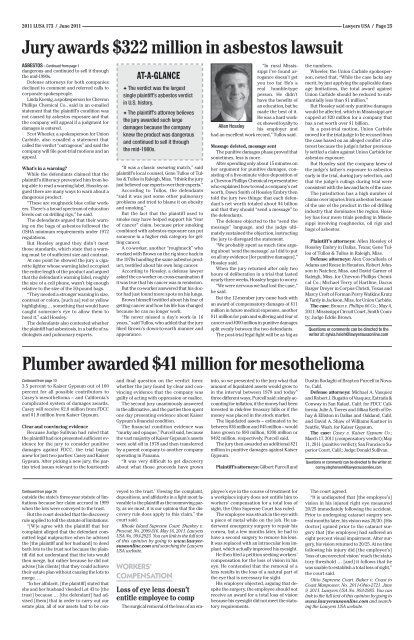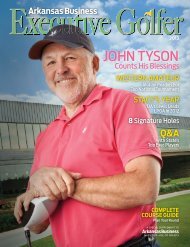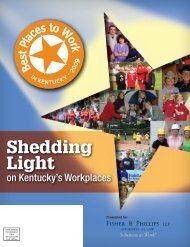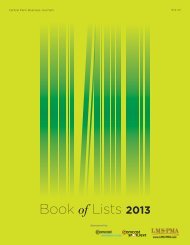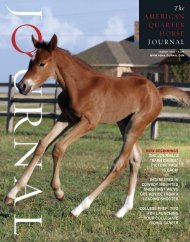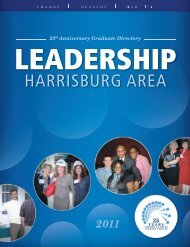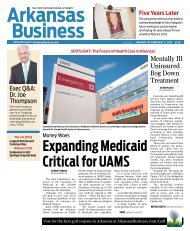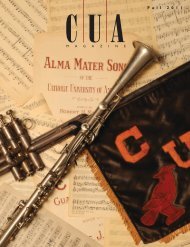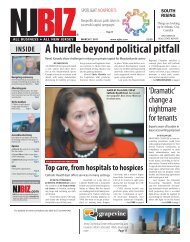Page 24 / Lawyers USA June 2011 / 2011 LUSA 172TOP DECISIONSPERSONAL INJURY& TORTContinued from page 23from the 3rd Circuit.The widow of a railroad worker broughtsuit on her husband’s behalf after he diedfrom mesothelioma, which she alleged hedeveloped due to asbestos exposure duringhis years of employment as a welder,machinist and supervisor for a railroad.The defendants removed the suit to federalcourt and moved for summary judgment,contending that the plaintiffs’ claimswere preempted by the federal LocomotiveInspection Act.The plaintiff argued that the design defectand failure to warn claims were not preemptedbecause the Act only preempts theregulation of locomotive equipment.But a U.S. District Court disagreed, grantingsummary judgment to the defendants,and the 3rd Circuit affirmed.“Congress intended to preempt all statelaws, regulations, and causes of actionwhich involve ‘the design, the construction,and the material of every part of the locomotiveand tender of all appurtenances.’The plaintiffs’ claims undeniably involvethe material used in locomotive parts, bothof which fall under the definition of ‘partsand appurtenances’ of locomotives, andtherefore are preempted by federal law. …“Congress’s intent in enacting andamending the LIA was to preempt completelythe field of railroad parts and appurtenances,and … the locomotive componentswhich are the subject of the plaintiffs’product liability action undoubtedlyfall within that category,” the court said.It noted that no other federal appellatecourts had decided the issue, but the majorityof state courts had reached a similarconclusion, including Alabama, California,Ohio and West VirginiaA decision from the U.S. Supreme Courtis expected next term.Kurns v. Railroad Friction Prods. Corp., No.10-879. Certiorari granted June 6, 2011. Rulingbelow: 620 F.3d 392 (Pa. 2010).Supreme Court rules inqualified immunity caseThe U.S. Supreme Court may generallyreview a lower court’s constitutional rulingwhere government officials won a final judgmenton qualified immunity grounds.However, in this instance the Court dismissedthe case as moot for other reasons.The suit was filed by the mother of anine-year-old girl who was interrogated fortwo hours at her elementary school by acounty deputy and child welfare workerconcerned about allegations that her fatherhad sexually abused her.Her mother filed a §1983 lawsuit, arguingthat her daughter’s Fourth Amendmentrights had been violated.The 9th Circuit agreed that the child’srights had been violated, but held that theofficers were shielded by qualified immunityfrom monetary liability.The officers appealed, and the U.S.Supreme Court granted certiorari.In a decision authored by Justice ElenaKagan, the majority determined that the decisioncould be reviewed by the Court becauseof the constitutional issues at play,even though the officers were the prevailingparties below.“No mere dictum, a constitutional rulingpreparatory to a grant of immunity createslaw that governs the official’s behavior. If ourusual rule pertaining to prevailing parties applied,the official would ‘fac[e] an unenviablechoice’: He must either acquiesce in a rulinghe had no opportunity to contest in thisCourt, or ‘defy the views of the lower court,adhere to practices that have been declaredillegal, and thus invite new suits and potentialpunitive damages,’” the Court said.The justices emphasized that the authorityto review such cases was limited to theSupreme Court, and that they were delineatingwhat they may review; “what we actuallywill choose to review is a different matter.”However, despite their power to review thecase, the Court dismissed it as moot, followinga line of questions raised at oral argument.“Time and distance combined havestymied our ability to consider this petition,”as the family had moved to a differentstate and the child at issue is nearly 18years old, the Court said.Chief Justice John Roberts and JusticesAntonin Scalia, Ruth Bader Ginsburg andSamuel Alito joined Kagan’s opinion. JusticeSonia Sotomayor filed an opinion concurringin the judgment, joined by JusticeStephen Breyer. Justices Anthony Kennedyand Clarence Thomas dissented.U.S. Supreme Court. Camreta v. Greene,No. 09-1454. May 26, 2011. Lawyers USA No.993-2940. You can link to the full text of thisopinion by going to www.lawyersusaonline.comand searching the Lawyers USAwebsite.Two-tier damages capis constitutionalThe state’s two-tier cap on damages isconstitutional, the South Carolina SupremeCourt has ruled.The plaintiffs were injured when their motorcyclecollided with a car in an intersection.The red signal light for the car hadburned out earlier that day and the plaintiffsfiled suit against the South Carolina Departmentof Transportation and the stateDepartment of Public Safety. They allegedthat the DOT failed to implement an appropriatere-lamping policy, and the DPS failedto notify a trooper to direct traffic at the intersectionafter a caller reported the outage.A jury agreed, awarding $1.875 million tothe plaintiffs.The defendants sought to reduce the verdictunder the state’s two-tier damages cap,arguing that the plaintiffs’ injuries resultedfrom a single “occurrence” under state law.The trial court agreed, cutting the verdictto $600,000.The plaintiffs appealed, arguing thedamages cap was unconstitutional andthat two separate occurrences gave riseto their injuries.Under a rational basis review, the courtconcluded that the damages cap was constitutionalbecause it “relieved the governmentfrom the hardships of unlimited liability”and “furthered accountable andcompetent healthcare while promoting affordablemedical liability insurance.”“[E]ven taking all of [the plaintiffs’] evidenceinto account, it cannot overcome thegreat deference this court must give” to thestate legislature, the court said.But the court decided that two separateoccurrences gave rise to the plaintiffs’ injuries,raising their reduced verdict to $1.2million“[T]wo independent and separate actsof negligence occurred here <strong>–</strong> one by [DOT]and one by [DPS]. There is no indicationthat the [defendants’] actions combined toform a single act of negligence. … We canfind no causal connection between the actionsof [DOT] and [DPS]; had the jury notfound [DOT] negligent, the verdict against[DPS] could still stand, and the converse isalso true,” the court said.South Carolina Supreme Court. Boiter v.South Carolina Department of Transportation,No. 26981. June 6, 2011. Lawyers USANo. 993-2979. You can link to the full text ofthis opinion by going to www.lawyersusaonline.comand searching the LawyersUSA website.Florida’s med-mal capis constitutionalFlorida’s $1 million cap on noneconomicdamages in medical malpractice cases doesnot violate the federal constitution, the 11thCircuit has ruled in affirming judgment.The plaintiffs’ daughter died as the resultof complications from childbirth. As amilitary dependent, the woman receivedcare from U.S. Air Force obstetricians.The plaintiffs sued under the FederalTort Claims Act, alleging that their daughter’sdeath was caused by the negligence ofAir Force doctors.A federal judge found the government liableand concluded that the plaintiffs sustainednearly $3 million in damages, $2 millionof which were noneconomic. However,the judge applied Florida’s statutory capfor medical malpractice claims and limitedthe plaintiffs’ recovery of noneconomicdamages to $1 million.The plaintiffs argued that Florida’s damagescap violated the Equal ProtectionClause of the Fourteenth Amendment to theU.S. Constitution.But the 11th Circuit disagreed, explainingthat the Florida legislature “identified a legitimategovernmental purpose in passing thestatutory cap, namely to reduce the cost ofmedical malpractice. The means that Floridachose, a per incident cap on noneconomicdamages, bears a rational relationship to thatend. The Florida legislature could reasonablyhave concluded that such a cap would reducedamage awards and in turn make medicalmalpractice insurance more affordableand healthcare more available.”The court further decided that the statelaw did not violate the Takings Clause.It proceeded to certify to the FloridaSupreme Court certain questions regardingthe validity of the damages cap under thestate constitution.U.S. Court of Appeals, 11th Circuit. Estateof McCall v. U.S., No. 09-16375. May 27, 2011.Lawyers USA No. 993-2949. You can link tothe full text of this opinion by going towww.lawyersusaonline.com and searchingthe Lawyers USA website.Yaz/Yasmin claims can’tproceed as class actionPlaintiffs are not entitled to class certificationon claims that they suffered injuriesas a result of taking the oral contraceptivesYaz and Yasmin, a U.S. District Court in Illinoishas ruled.The plaintiff sued Bayer, alleging that shesuffered deep vein thrombosis as a result oftaking Yaz. She sought certification of a nationwideclass of all those with Yaz or Yasminrelatedpersonal injury claims against Bayer.The plaintiff’s case was consolidated inmultidistrict litigation in Illinois with thousandsof other similar cases from across thecountry. The first bellwether trial in the litigationis set for Sept. 2011. (See “First bellwetherYaz, Yasmin trial set for 2011,”Lawyers USA, Oct. 21, 2010. Search termsfor Lawyers USA’s website: Yasmin.)In this proceeding, Bayer moved to dismissthe class allegations in the plaintiff’scomplaint.The court agreed that the individual issuesrelating to the putative class membersprecluded class certification.It explained that “almost every elementof the asserted claims will require highly individualizedfactual inquiries unique notonly to each class member but also to eachclass member’s prescribing physician. …“For example, … establishing causationwill require (1) an examination of each classmember’s medical history, including preexistingconditions and use of other medications;(2) an evaluation of potential alternatecauses for the alleged injury; and(3) an assessment of individualized issuespertaining to each class member’s prescriber,including how the doctor balancesthe risks and benefits of the medicine forthat particular patient, the particular doctor’sprescribing practices, the doctor’sknowledge about the subject drug, and thedoctor’s sources of information with regardto the subject drug.”U.S. District Court for the Southern Districtof Illinois. In re Yasmin and Yaz Products LiabilityLitigation, No. 3:09-md-02100-DRH-PMF. May 4, 2011. Lawyers USA No. 993-2926.You can link to the full text of this opinion bygoing to www.lawyersusaonline.com andsearching the Lawyers USA website.REAL PROPERTY& ZONINGSuccessor property ownercan’t evict tenantA successor property owner could notevict a tenant without providing the 90-daywritten notice required under a federal lawprotecting renters’ rights in the context offoreclosure, the Arizona Court of Appealshas ruled in reversing judgment.A defendant rented a property that abank acquired in a trustee’s sale after theoriginal property owner defaulted on anote. The day after the trustee’s deed wasrecorded, the bank sent the defendant a noticedemanding that she vacate the premiseswithin five days.The defendant refused to comply withthe demand and more than three monthslater the bank filed a forcible entry and detaineraction.The defendant argued that she could notbe evicted because the bank failed to complywith the 90-day written notice requirementof the Protecting Tenants at ForeclosureAct. The federal law was passed in2009 and is designed to protect tenantswho reside in certain foreclosed properties.The bank argued that it satisfied the Act’srequirements because it waited more than90 days before it filed the forcible entry anddetainer action.But the court concluded that the five-daynotice originally received by the defendantwas insufficient, noting that the Act includesa right for the tenant to occupy thepremises until the end of the lease, as wellas a right to receive a notice to vacate 90days before the effective date.“Obviously, a five-day notice, even whenfollowed by an unannounced 90-day delay,is at best misleading. The noticed tenantcould reasonably conclude that all arrangementsto vacate the property and relocatemust be concluded within the five-day noticeperiod. Such misleading informationwould not be consistent with the [Act’s] requirement,”the court said.Arizona Court of Appeals. Bank of NewYork Mellon v. De Meo, No. 1 CA-CV 10-0177.May 3, 2011. Lawyers USA No. 993-2897. Youcan link to the full text of this opinion by goingto www.lawyersusaonline.com andsearching the Lawyers USA website.TAXATION & ESTATEPLANNINGLawyer can be sued fornegligent estate planningThe discovery rule tolled the statute oflimitations in a lawsuit against a lawyerwho allegedly provided bad advice in thepreparation of an estate plan, the Rhode IslandSupreme Court has ruled in reversinga dismissal.The plaintiff and her husband retained thedefendant to prepare an estate plan in 1999.Under the plan, the couple quitclaimed twoadjoining lots of land to a trust.In 2003, after her husband died, the plaintiffattempted to sell one of the lots.However, local zoning officials advisedher that the conveyance of the adjoininglots to the trust had resulted in their merger,meaning that they could not be soldseparately.In 2006, the plaintiff sued the defendantfor malpractice.The defendant argued that the lawsuit wasContinued on page 25
2011 LUSA 173 / June 2011 Lawyers USA / Page 25Jury awards $322 million in asbestos lawsuitASBESTOS <strong>–</strong> Continued from page 1dangerous and continued to sell it throughthe mid-1980s.Defense attorneys for both companiesdeclined to comment and referred calls tocorporate spokespeople.Linda Koenig, a spokesperson for ChevronPhillips Chemical Co., said in an e-mailedstatement that the plaintiff’s condition wasnot caused by asbestos exposure and thatthe company will appeal if a judgment fordamages is entered.Scot Wheeler, a spokesperson for UnionCarbide, also e-mailed a statement thatcalled the verdict “outrageous” and said thecompany will file post-trial motions and anappeal.What’s in a warning?While the defendants claimed that theplaintiff’s illiteracy prevented him from beingable to read a warning label, Hossley arguedthere are many ways to warn about adangerous product.“These are roughneck blue collar workers.There’s a broad spectrum of educationlevels out on drilling rigs,” he said.The defendants argued that their warningon the bags of asbestos followed theOSHA minimum requirements under 1972regulations.But Hossley argued they didn’t meetthose standards, which state that a warningmust be of sufficient size and contrast.At one point he showed the jury a cigarettelighter whose warning label occupiedthe entire length of the product and arguedthat the defendant’s warning label, roughlythe size of a cell phone, wasn’t big enoughrelative to the size of the 50-pound bags.“They needed a stronger warning in size,contrast or colors, [such as] red or yellowhighlighting … something that would havecaught someone’s eye to allow them toheed it,” said Hossley.The defendants also contested whetherthe plaintiff had asbestosis, in a battle of radiologistsand pulmonary experts.AT-A-GLANCE✦ The verdict was the largestsingle plaintiff’s asbestos verdictin U.S. history.✦ The plaintiff’s attorney believesthe jury awarded such largedamages because the companyknew the product was dangerousand continued to sell it throughthe mid-1980s.“It was a classic swearing match,” saidplaintiff’s local counsel, Gene Tullos of Tullos& Tullos in Raleigh, Miss. “I think the juryjust believed our experts over their experts.”According to Tullos, the defendants“said it was just some other pulmonaryproblems and tried to blame it on obesityand smoking.”But the fact that the plaintiff used tosmoke may have helped support his “fearof cancer” claim, because prior smokingcombined with asbestos exposure can putsomeone in a higher risk category for gettingcancer.A co-worker, another “roughneck” whoworked with Brown on the rig since back inthe 1970s handling the same asbestos product,testified about his own lung cancer.According to Hossley, a defense lawyerasked the co-worker on cross-examination ifit was true that his cancer was in remission.But the co-worker answered that his doctorhad just found more spots on his lungs.Brown himself testified about his fear ofgetting cancer and how his life has changedbecause he can no longer work.“He never missed a day’s work in 16years,” said Tullos, who added that the juryliked Brown’s down-to-earth manner andappearance.“In rural MississippiI’ve found arrogancedoesn’t getyou too far. He’s areal humble-typeperson. He didn’thave the benefits ofan education, but hemade the best of it.He was a hard worker,showed loyalty toAllen Hossleyhis employer andhad an excellent work record,” Tullos said.Message deleted, message sentThe punitive damages phase proved thatsometimes, less is more.After spending only about 15 minutes onher argument for punitive damages, consistingof a five-minute video deposition ofa Chevron Phillips Chemical representativewho explained how to read a company’s networth, Dawn Smith of Hossley Embry thentold the jury two things: that each defendant’snet worth totaled about $4 billionand that they should “send a message” tothe defendants.The defense objected to the “send themessage” language, and the judge ultimatelysustained the objection, instructingthe jury to disregard the statement.“We probably spent as much time arguingabout ‘send the message’ as I did to puton all my evidence [for punitive damages],”Hossley said.When the jury returned after only twohours of deliberation in a trial that lastednearly three weeks, Hossley began to worry.“We were nervous we had lost the case,”he said.But the 12-member jury came back withan award of compensatory damages of $11million in future medical expenses, another$11 million for pain and suffering and fear ofcancer and $300 million in punitive damagessplit evenly between the two defendants.The post-trial legal fight will be as big asthe numbers.Wheeler, the Union Carbide spokesperson,noted that, “While the case lacks anymerit, by just applying the applicable damagelimitations, the total award againstUnion Carbide should be reduced to substantiallyless than $1 million.”But Hossley said only punitive damageswould be affected, which in Mississippi arecapped at $20 million for a company thathas a net worth over $1 billion.In a post-trial motion, Union Carbidemoved for the trial judge to be recused fromthe case based on an alleged conflict of interestbecause the judge’s father previouslysettled a claim against Union Carbide forasbestos exposure.But Hossley said the company knew ofthe judge’s father’s exposure to asbestosearly in the trial, during jury selection, andthat the judge’s rulings during trial wereconsistent with the law and facts of the case.The jurisdiction has a high number ofclaims over injuries from asbestos becauseof the use of the product in the oil drillingindustry that dominates the region. Hossleyhas four more trials pending in Mississippiinvolving roughnecks, oil rigs andbags of asbestos.Plaintiff’s attorneys: Allen Hossley ofHossley Embry in Dallas, Texas; Gene Tullosof Tullos & Tullos in Raleigh, Miss.Defense attorneys: Alex Cosculluela ofAdams and Reese in Houston, Robert Johnsonin Natchez, Miss. and David Garner ofRaleigh, Miss. for Chevron Phillips ChemicalCo.; Michael Terry of Hartline, DacusBarger Dreyer in Corpus Christi, Texas andMarcy Croft of Forman Perry Watkins Krutz& Tardy in Jackson, Miss. for Union Carbide.The case: Brown v. Phillips 66 Co.; May 4,2011; Mississippi Circuit Court, Smith County;Judge Eddie Brown.Questions or comments can be directed to thewriter at: sylvia.hsieh@lawyersusaonline.comPlumber awarded $41 million for mesotheliomaContinued from page 133.5 percent to Kaiser Gypsum out of 100percent for all possible contributors toCasey’s mesothelioma <strong>–</strong> and California’scomplicated system of damages awards,Casey will receive $2.8 million from FDCCand $1.8 million from Kaiser Gypsum.Clear and convincing evidenceBecause Judge Sullivan had ruled thatthe plaintiff had not presented sufficient evidencefor the jury to consider punitivedamages against FDCC, the trial begananew for just two parties: Casey and KaiserGypsum. After picking a new jury, the partiestried issues relevant to the fourteenthand final question on the verdict form:whether the jury found by clear and convincingevidence that the company wasguilty of acting with oppression or malice.The second jury unanimously answeredin the affirmative, and the parties then spentone day presenting evidence about KaiserGypsum’s financial condition.The financial condition evidence was“murky and opaque,” Purcell said, becausethe vast majority of Kaiser Gypsum’s assetswere sold off in 1978 and then transferredby a parent company to another companyoperating in Panama.“It was very difficult to get discoveryabout what those proceeds have growninto, so we presented to the jury what thatamount of liquidated assets would grow toin the interval between 1978 and today”three different ways, Purcell said: simply accountingfor inflation, if the money had beeninvested in risk-free treasury bills or if themoney was placed in the stock market.The liquidated assets <strong>–</strong> estimated to bebetween $36 million and $45 million <strong>–</strong> wouldhave grown to $90 million, $200 million or$492 million, respectively, Purcell said.The jury then awarded an additional $21million in punitive damages against KaiserGypsum.Plaintiff’s attorneys: Gilbert Purcell andDustin Bodaghi of Brayton Purcell in Novato,Calif.Defense attorneys: Michael A. Vasquezand Robert J. Bugatto of Vasquez, Estrada &Conway in San Rafael, Calif. for FDCC California;Julie A. Torres and Jillian Keith of Dehay& Elliston in Dallas and Oakland, Calif.and David A. Shaw of Williams Kastner inSeattle, Wash. for Kaiser Gypsum.The case: Casey v. Kaiser Gypsum Co.;March 17, 2011 (compensatory verdict); May11, 2011 (punitive verdict); San Francisco SuperiorCourt, Calif.; Judge Donald Sullivan.Questions or comments can be directed to the writer at:correy.stephenson@lawyersusaonline.comContinued from page 24outside the state’s three-year statute of limitationsbecause her claim accrued in 1999when the lots were conveyed to the trust.But the court decided that the discoveryrule applied to toll the statute of limitations.“[W]e agree with the plaintiff that hercomplaint alleged that the defendant committedlegal malpractice when he advisedthe [the plaintiff and her husband] to deedboth lots to the trust not because the plaintiffdid not understand that the lots wouldthen merge, but rather because he did notadvise [his clients] that they could achievetheir estate plan without causing the lots tomerge. …“In her affidavit, [the plaintiff] stated thatshe and her husband ‘deeded Lot 43 to [thetrust] because … [the defendant] had advised[them] that in order to carry out ourestate plan, all of our assets had to be conveyedto the trust.’ Viewing the complaint,depositions, and affidavits in a light most favorableto the plaintiff as the nonmoving party,as we must, it is our opinion that the discoveryrule does apply to this claim,” thecourt said.Rhode Island Supreme Court. Sharkey v.Prescott, No. 2009-316. May 16, 2011. LawyersUSA No. 993-2923. You can link to the full textof this opinion by going to www.lawyersusaonline.comand searching the LawyersUSA website.WORKERS’COMPENSATIONLoss of eye lens doesn’tentitle employee to compThe surgical removal of the lens of an employee’seye in the course of treatment fora workplace injury does not entitle him toworkers’ compensation for a total loss ofsight, the Ohio Supreme Court has ruled.The employee was struck in the eye witha piece of metal while on the job. He underwentemergency surgery to repair hiscornea, but a few months later, he had tohave a second surgery to remove his lens.It was replaced with an intraocular lens implant,which actually improved his eyesight.He then filed a petition seeking workers’compensation for the loss of vision in hiseye. He contended that the removal of alens results in the loss of a natural part ofthe eye that is necessary for sight.His employer objected, arguing that despitethe surgery, the employee should notreceive an award for a total loss of visionbecause his eyesight did not meet the statutoryrequirements.The court agreed.“It is undisputed that [the employee’s]vision in his injured right eye measured20/25 immediately following the accident.Prior to undergoing cataract surgery severalmonths later, his vision was 20/30. [Hisdoctor] opined prior to the cataract surgerythat [the employee] had suffered aneight percent visual impairment. After surgery,his vision returned to 20/25. At no timefollowing his injury did [the employee’s]‘loss of uncorrected vision’ reach the statutorythreshold … [and] it follows that hewas unable to establish a total loss of sight,”the court said.Ohio Supreme Court. Baker v. Coast toCoast Manpower, No. 2011-Ohio-2721. June9, 2011. Lawyers USA No. 993-2985. You canlink to the full text of this opinion by going towww.lawyersusaonline.com and searchingthe Lawyers USA website.


